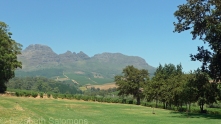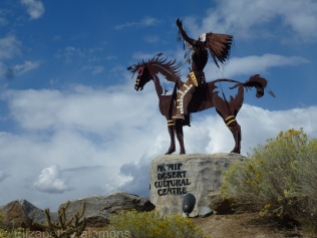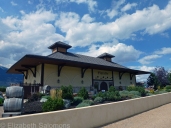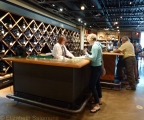Harvesting Grapes in Provence

When I booked a gîte for our week in Provence, I really had no idea what I’d done.
I knew I wanted to spend a week in Provence. I knew I wanted to stay in a gîte. And I knew that a gîte is a self-catering holiday home in rural France — that much I had learned on a previous visit to the south of France.
Beyond that (and a budget), I set no parameters in my search for accommodation. The place I ended up booking for myself and my friends was not our first choice or even our second choice. But when the owners of Domaine du Crestet sent such a friendly reply with so much detailed information to my inquiry about availability, we were sold.
Domaine du Crestet is a wine estate that dates back to the mid-1800s. Several stone-walled buildings have been converted into guest apartments and a home for the owners. The apartment we rented for the week was in a building that used to be a barn filled with silk worms.

What I didn’t know about the gîte I had booked was that it is a working vineyard, known as a domaine. And, because it was a working vineyard, we had the additional bonus of a crash course in wine production as part of our stay.
Our education began the moment we arrived as a wine reception was underway for all of the guests. (Accommodation at this particular gîte was booked Saturday to Saturday, so all of the guests for the week arrived on the same day.)
It continued mid-week when we enjoyed for a small fee a wine-tasting evening put on by Paul, our host. He knowledgeably led us through nine different wines and sent each of us home with the remains of a bottle (or two) at the end of the evening. A few days later, with only one or two wrong turns, my friends and I were able to locate one of the châteaux on Paul’s list so we could purchase for ourselves several bottles of the Châteauneuf-du-Pape wine he had introduced us to.
But it was our final day at the gîte when the real learning took place. Paul offered us a deal: if we were willing to spend the day picking grapes for him and his neighbour, we would be treated to a picnic lunch as well as dinner at the neighbour’s home. It took my friends and me only a few minutes to decide. Although field work wasn’t exactly on our holiday agenda, we knew this was too interesting an opportunity to turn down.

We were ready for work at 8:00 a.m. sharp. The vineyard was right beside the domaine, so we only had to walk out the door. Joining the three of us Canadians on that beautifully cool morning was a German couple, also guests at the gîte, whom we had met at the wine-tasting evening. Jean-Louis, the neighbour, soon showed up with his tractor and cart.
Jean-Louis spoke no English, so Paul translated for him. We were shown how to hold the bunch of grapes in one hand and the cutters with the other. No holding the stem ― that’s the way you end up cutting yourself. I paid careful attention. The cutters were terribly sharp and I began having flashbacks to my summers working at a tree and plant nursery that involved many long days of pruning pine trees.
Only grapes that looked good enough to eat went into the plastic containers; the dried or rotten ones were to be left on the ground. Once a container was full, we were to empty it into the cart.

Truth be told, picking grapes isn’t nearly as tough as pruning pine trees. Or picking strawberries or planting leeks ― all of which I’ve done for days on end. It would have been easier on me had I been a tad shorter (less crouching), and it also helps to have big hands in which to hold the grape bunches.
We hadn’t been picking long when Jean-Louis stopped us. He wanted to show us how he tested the sugar level of the grapes. First he crushed a few grapes, then he poured the juice into a gizmo that Google tells me was a refractometer. We took turns looking through the eye piece to see the sugar level for ourselves. The sugar level is an indicator of what the alcohol content will be of the wine produced from those grapes.
During another break, Paul had us walk over to the next vineyard where other neighbours were picking table grapes. These grapes were much sweeter than wine grapes, and instead of dumping the grapes into a cart, they were carefully placed onto cardboard flats. One of the pickers was Jean-Louis’ mother-in-law and we learned that she was going to be cooking dinner for us that evening. She kept handing us grapes to eat until we couldn’t eat anymore.
By the time we finished at Domaine du Crestet, the sun was high above us. We changed into shorts and put on sun hats. Our picnic lunch had been brought over by Jean-Louis in his cart, which was now half filled with grapes. We put the coolers and baskets in our cars, gave Jean-Louis a head start with his tractor and cart, and then drove over to his vineyard, about 10 minutes away by car.

We parked our cars near an olive grove, put the coolers and baskets in the shade, then began picking grapes in this much older vineyard. But only 20 minutes later, Jean-Louis announced it was lunch time.
And what a lunch! We carried the coolers and baskets to the olive grove and sat down in a circle. Jean-Louis opened up the baskets and began passing out the food: two enormous quiches, baguettes, cheese, sausage, wine, water, more cheese, more wine, more quiche … I’m not exaggerating when I say it was the best picnic I’ve ever had. (And! We were picnicking in an olive grove!!)

While we ate, we talked about grapes and making wine, with Paul doing all the translating from French into English and back into French.
And this is what I learned.
Most grapes in France are picked nowadays by machine. But young vineyards, like Domaine du Crestet’s, have to be picked by hand because the vines are so small. And the rows of vines in old vineyards, like Jean-Louis’, were planted too close together to allow the machines to pass through.
A vineyard can only call itself a château if it actually has a château on the property. Otherwise, it’s a domaine.
Paul and Jean-Louis are part of the same cave coopérative (cooperative cellar), which is why they were harvesting the grapes together and why it didn’t matter that grapes from two different vineyards were all mixed up in one cart. The type of grapes we were picking were called Grenache.
Jean-Louis was on the board of the coopérative, which is highly regulated. Members are told when they can start harvesting and when the harvest has to be finished by. The coopérative also regulates when the farmers can and should replant. The older the grapes, the better the wine but the lower the output, so at some point, farmers have to work out which is more cost-effective ― making more expensive wine, but less of it, or making less expensive wine, but more of it. Jean-Louis kept testing the sugar level of the grapes all day long and the sugar level of the grapes from his 60-year-old vines was nearly twice that of the grapes from the three-year-old vines at Domaine du Crestet.
Only once we’d eaten and drunk our fill, and had run out of questions, did we pack up the remains of the lunch and head back to the vines. This was the difficult bit ― who wants to do field work after a lunch like that? ― but we kept at it. I knew from my summers of working at the nursery and on an organic vegetable farm that farmers can be particular in how you work in their fields and Jean-Louis was no different. Paul muttered to me that he wondered if we would be able to finish that afternoon. It seemed like the rows went on forever. But then, all of a sudden, Jean-Louis announced we were on the last row. It wasn’t the end of the field, but it was the end of his vines. No fence, no marker, no nothing. I guess he just knew or had counted off the rows while we worked.
We had a drink or three of water from the bottles that were sitting by the dregs of our picnic lunch and then washed our hands, taking turns pouring water over each other’s hands. Jean-Louis drove off with the harvest and the rest of us admired the view for a while. It was a beautiful piece of land with a marvellous view of Mont Ventoux.

When Paul figured we’d given Jean-Louis enough of a head start, we drove to the cave where the coopérative makes its wine. We passed Jean-Louis along the way, and after we parked our cars, Paul took us around to the back where all the grapes were brought.
So much activity! The place was abuzz with farmers and tractors and carts identical to Jean-Louis’. When Jean-Louis eventually showed up, he backed his cart into the correct spot (there was a board directing the farmers as each type of grape has to go in a particular place), then the cart was lifted up by a hydraulic control on the tractor and the grapes slid into a bin. A giant screw pushed the grapes towards a small opening at the opposite end of the bin. It took about 10 or 15 minutes for the bin to empty.

We found out we had picked 2000 pounds. Jean-Louis joked that “real” pickers would have been able to pick 4000 or 5000 pounds, but Paul told us later that Jean-Louis was actually rather pleased with our work, given that we were novice pickers. He was also pleased that the alcohol content of our grapes was 14.1%, which apparently is pretty good.

After the grapes we picked were on their way, we were given a tour of the cave. Paul started, but then another guy took over, whom we later learned was the director of the coopérative. Compared to other caves I’ve toured in France, this one was much more modern with concrete and gleaming metal everywhere, and not a single oak barrel in sight. At one point, I was instructed to take a whiff of the fermenting wine. At first I smelled nothing, so I was told to sniff harder. And then … wow! The carbon dioxide emitted by the fermentation process goes straight to your brain. Powerful stuff, and lethal, of course, if you were to fall into the vat.
When the tour was over, we went around to the front of the cave where the wine store was located to taste some wine and so Jean-Louis could choose one for our dinner. He bought six bottles and then whispered something to Paul, who later told us Jean-Louis had asked him if he thought six bottles would be enough for the evening.
Uh … yes. It most certainly would be, as I was about to find out.
But the story of how that wine tasted — and dinner with Jean-Louis and his family — will have to wait until my next post.

Stellenbosch

If I had any doubts I was on the other side of the world when I arrived in South Africa near winter’s end almost five years ago, they were put to bed 48 hours later after a day of wine tasting. That’s when I discovered how topsy-turvy I was ― in South Africa, grape harvest takes place between February and April.

South Africa’s first vineyards were planted some 350 years ago by French Huguenots who brought vine cuttings with them from France. As of last year, the country is ranked seventh in the world by volume of wine produced. (Canada isn’t even in the top 30.)
It hasn’t been an easy ride to seventh place, however. The economic sanctions against South Africa during the apartheid regime nearly destroyed its wine industry and are still having an impact. Many producers sold their grapes to cooperatives that produced poorly blended bulk wine ― what became known as “supermarket wine.” The practice continued for several years after sanctions were lifted so that, even today, some 20 years later, the country is still trying to shed its reputation as a producer of plonk.
Like the BC winemakers after the FTA and NAFTA, South African winemakers knew they had to start over. They ripped out their vines and replanted to improve the quality of their grapes. Nowadays, these winemakers talk about their industry as having two eras: before Mandela and after.

Stellenbosch is one of three wine regions in the Western Cape wine region of South Africa. Its Mediterranean-like climate, with hot dry summers and cool wet winters, is well-suited for growing grapes, the most popular of which is Chenin blanc. Evidence of how far the region has come since apartheid: at the 2014 Decanter World Wine Awards, Stellenbosch wineries earned 181 medals, of which two were international trophies, one was a regional trophy, and two were gold medals.
Immediately prior to my arrival in South Africa, I’d spent three months in France, imbibing in, well, let’s just say, a lot of French wine. Even so, I was extremely impressed by the wine I tasted in South Africa and was surprised by the number of vineyards we drove past during our day-long wine-tasting tour through Stellenbosch.

The first winery we stopped at was Meerlust. Established in 1756, it is one of South Africa’s oldest wineries and has been in the same family for eight generations. It is also of the few wineries that maintained its production of fine wine throughout the apartheid regime, despite the lack of access to world markets.
Bilton was our next stop, and we paid a little extra to pair our wine tasting with chocolate. After the tasting, we had lunch ― most of the wineries also have a restaurant on-site ― and I enjoyed my first taste of bobotie. A curried meatloaf with a custard-like topping, bobotie is to South Africa what poutine is to Canada.
Next was Warwick Estates, which dates back to 1771. In the 1970s, a South African and his Canadian wife ― a former ski instructor from Alberta ― worked hard to transform the farm into a winery of some distinction. That ski instructor, Norma Ratcliffe, is still making wine and is the only female member of the Cape Winemakers Guild. Today, Warwick Estates is considered one of the best wineries in the world, known for its Bordeaux-style blends regularly served at South African state dinners. Sadly, the wine is not available in Canada, despite the estate’s best efforts to crack the nut that is our country’s government-controlled liquor boards.
L’Avenir was our last stop of the day, its name a tribute to the French Huguenot heritage of the region. Along with Warwick, it was the prettiest winery we visited.

Stellenbosch is rimmed by mountains, and its landscape reminded me of BC’s Okanagan. The distinctive design of the Cape Dutch architecture, with its white, rounded gables, set the place apart from any other wine region I’ve visited, however.

After returning to Canada, I told my local wine seller that I was seriously disappointed with the selection of South African wine in Vancouver, at which point I was told, “there’s no market for it.”
And so, since then, I’ve been on a one-woman mission to create some demand for South African wine in this country.
The Okanagan

When I was growing up in Edmonton, I knew the Okanagan as the place where Albertans headed to every summer in droves. It was considered the perfect family vacation destination by the parents of my school friends, who went there every summer and came back with stories of long days spent swimming and boating in lakes. (My family went to the mountains instead ― a choice my parents made that I personally had no issues with.)
Nowadays, the Okanagan is still a popular summer lake district, but that dry, sunny, Mediterranean-like climate that makes it so popular with boaters and swimmers is also what makes the region perfectly suited to growing grapes.

Those grapes get harvested in the fall, and this year the Okanagan had a bumper crop. While setting a record for the earliest start of harvest ever (August 12) ― thanks to a hot and dry spring and summer ― this year’s grapes were smaller than usual. That’s not necessarily a bad thing. Smaller grapes mean less product, but it can also mean a higher quality wine because the flavour and colour is concentrated.
Fall is also wine festival time. If you happened to be in the Okanagan earlier this month, you could have participated in some of the 125 events that make up the Fall Okanagan Wine Festival with 20,000 of your closest wine-loving friends. This year was the festival’s 35th anniversary.
Yup. That’s 35 years of wine festivalling. But it might surprise you to learn that the tradition of winemaking in the Okanagan goes back to before the birth of Canada. The first person to plant grapes in the Okanagan was Father Charles Pandosy, a Catholic missionary who came to the area in 1859. He needed wine, as all priests do, to be able to administer Mass, and so he planted himself a vineyard.
The first commercial winery ― Calona Vineyards ― was established in Kelowna in 1932 and is still in business. In 1968, Nk’Mip (in-ka-meep) Cellars was established in Osoyoos. Fourteen years later, there were 14 wineries operating in the Okanagan.
And the quality of Okanagan wine back in the 1980s? Well, let’s be generous and call it plonk.
Then along came free trade. It turns out that the Free Trade Agreement of 1988 was the best thing to happen to BC’s wine industry. After losing their preferred status in BC liquor stores, Okanagan winemakers knew they had to improve their product ― fast ― if they were going to complete on the world stage of vintners. So what did they do? They pulled up two-thirds of their vines and replanted with vines that produced better quality grapes suitable for making premium quality wine.

And here’s the amazing thing: the BC winemaking industry exploded. There were 17 wineries in 1990; by 1994, that number had doubled. It doubled again by 2000 and again by 2008. As of last year, there were 254 wineries in operation in the Okanagan with 10,259 acres of vines planted. (To be honest, the rapid expansion of vineyards is beginning to threaten BC’s fruit industry because long-time fruit growers are pulling up their orchards to plant vines. They know they can earn far more from growing grapes than they can from growing peaches and cherries.)
The awards started pouring in early on. The first big one was the 1994 Avery Trophy for Best Chardonnay in the World at London’s International Wine and Spirit Competition, awarded to Kelowna’s Mission Hill Winery. At the 2014 Decanter World Wine Awards (the world’s biggest competition with over 15,000 wines entered in 2014), Okanagan wineries took home 105 medals, including three regional trophies and four gold medals. (By comparison, Californian wineries took home 83 medals that year, none of which were trophies or gold medals.)
Okanagan wines are rather pricey ― some would argue overpriced ― for what you get. But here’s what I’ve learned: those high prices are due to the cost of labour and land. BC vineyard land is the most expensive in the world after Europe. And so, here’s a pro-tip: if you are on a budget, stick to the older Okanagan wineries for more affordable wines. They aren’t cheaper because the wines are lower quality ― they’re cheaper because those wineries bought land back in the 1990s before it got crazy expensive. Their overhead is much lower.
The Okanagan is divided into five subregions: Kelowna, Naramata Bench, Okanagan Falls, Golden Mile, and Black Sage Bench/Osoyoos. I made it to four of these subregions last summer on my way home from Alberta. Here’s a look at some of the wineries I got to. (Click on the first photo at top left to open up the slide show.)
In all, I visited nine wineries and did seven tastings over two days, starting in Osoyoos and finishing 120 km to the north in West Kelowna. I didn’t bother doing a tasting at either Quail’s Gate or Mission Hill ― their wines are readily available in Vancouver, and both tasting rooms, though impressive, were a bit of a zoo. I expected that, because the larger wineries attract the largest crowds, but I stopped at them anyways because I’d been told both were impressive operations and worth a look-see.
But here’s another pro-tip: the best wine-tasting experiences are to be had at the smallest of wineries. Serendipity, for example, is a place that holds up to its name. The tasting room is simple and unpretentious ― a cordoned-off end of a storage shed ― but I had the complete and undivided attention of the wine seller. That experience was wine-buying at its most fun.
Another winery worth a stop is Pentâge Winery on the Naramata Bench. I stopped here on the recommendation of my brother, who claimed it made the best Cabernet Franc he’d ever tasted. A stop at this winery involves a long, windy drive up the side of the mountain, and then a long, steep, windy ride down the side of the mountain that probably scares off timid and cautious drivers. In fact, the winemaker admitted that some visitors won’t even attempt the driveway and instead park their car up top and walk down. I found the tasting room at Pentâge a most pleasant oasis and, knowing it was going to be my last stop of the day, I took my time and chatted with the winemaker for a long while. That stop was the highlight of my two days of wine tasting. (Sadly, my camera was acting up and all my photos are out of focus.)
I won’t have the ways and means to do an Okanagan trip every summer, but I do know this: my wine-buying trip of this past summer has certainly opened my eyes to the best way to buy wine.





















